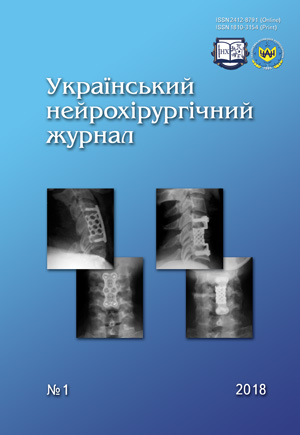Comparison of dynamics of neurological disorders regression in postoperative period in patients with subaxial cervical spine injury depending on constructive fusion system type
DOI:
https://doi.org/10.25305/unj.120822Keywords:
cervical spine injury, ventral cervical spinal fusion, neurological disorders, vertebral body replacement implantAbstract
Introduction. Two types of constructive solutions for fusion of subaxial cervical spine traumatic injury are possible. The first is an independent combination of interbody implant and anterior plating, the second one is the single telescopic implant that combines both principles.
Objective. To analyze the dynamics of regression of neurological disorders in patients with subaxial cervical spine traumatic injury who underwent anterior decompression-fusion surgery with different constructive type of fixation.
Materials and methods. Clinical material was presented by 25 patients with subaxial cervical spine traumatic injury, divided into two groups depending on the type of fusion system used during the operation. The dynamics of neurological disorders recovery was assessed using the International Standards for Neurological Classification of Spinal Cord Injury.
Results. The findings revealed a statistically significant difference in the intensity of neurological disorders recovery in patients at 3 and 6 months’ follow-up with a decisive advantage of single fusion system usage.
Conclusions. The usage of a telescopic implant for anterior interbody subaxial cervical fusion is clinically approved, since it indirectly provides more pronounced regression of neurological disorders.
References
1. Goldberg W, Mueller C, Panacek E, Tigges S, Hoffman JR, Mower WR; NEXUS Group. Distribution and patterns of blunt traumatic cervical spine injury. Ann Emerg Med. 2001 Jul;38(1):17-21. [CrossRef] [PubMed]
2. Yadollahi M, Paydar S, Ghaem H, Ghorbani M, Mousavi SM, Taheri Akerdi A, Jalili E, Niakan MH, Khalili HA, Haghnegahdar A, Bolandparvaz S. Epidemiology of Cervical Spine Fractures. Trauma Mon. 2016 Mar 16;21(3):e33608. eCollection 2016 Jul. [CrossRef] [PubMed] [PubMed Central]
3. Leucht P, Fischer K, Muhr G, Mueller EJ. Epidemiology of traumatic spine fractures. Injury. 2009 Feb;40(2):166-72. [CrossRef] [PubMed]
4. Passias PG, Poorman GW, Segreto FA, Jalai CM, Horn SR, Bortz CA, Vasquez-Montes D, Diebo BG, Vira S, Bono OJ, De La Garza-Ramos R, Moon JY, Wang C, Hirsch BP, Zhou PL, Gerling M, Koller H, Lafage V. Traumatic Fractures of the Cervical Spine: Analysis of Changes in Incidence, Cause, Concurrent Injuries, and Complications Among 488,262 Patients from 2005 to 2013. World Neurosurg. 2017 Nov 11. pii: S1878-8750(17)31930-7. [CrossRef] [PubMed]
5. Fredø HL, Bakken IJ, Lied B, Rønning P, Helseth E. Incidence of traumatic cervical spine fractures in the Norwegian population: a national registry study. Scand J Trauma Resusc Emerg Med. 2014 Dec 18;22:78. [CrossRef] [PubMed] [PubMed Central]
6. Chen Y, He Y, DeVivo MJ. Changing Demographics and Injury Profile of New Traumatic Spinal Cord Injuries in the United States, 1972-2014. Arch Phys Med Rehabil. 2016 Oct;97(10):1610-9. [CrossRef] [PubMed]
7. Oner C, Rajasekaran S, Chapman JR, Fehlings MG, Vaccaro AR, Schroeder GD, Sadiqi S, Harrop J. Spine Trauma-What Are the Current Controversies? J Orthop Trauma. 2017 Sep;31 Suppl 4:S1-S6. [CrossRef] [PubMed]
8. Sekhon LH, Fehlings MG. Epidemiology, demographics, and pathophysiology of acute spinal cord injury. Spine (Phila Pa 1976). 2001 Dec 15;26(24 Suppl):S2-12. [CrossRef] [PubMed]
9. Polishchuk NE, Korzh NA, Fishchenko VYa. Povrezhdeniya pozvonochnika i spinnogo mozga (mekhanizmy, klinika, diagnostika, lechenie). Kiev: Kniga plyus; 2001. Russian.
10. Ramón S, Domínguez R, Ramírez L, Paraira M, Olona M, Castelló T, García Fernández L. Clinical and magnetic resonance imaging correlation in acute spinal cord injury. Spinal Cord. 1997 Oct;35(10):664-73. [CrossRef] [PubMed]
11. Ahuja CS, Schroeder GD, Vaccaro AR, Fehlings MG. Spinal Cord Injury-What Are the Controversies? J Orthop Trauma. 2017 Sep;31 Suppl 4:S7-S13. [CrossRef] [PubMed]
12. Das K, Couldwell WT, Sava G, Taddonio RF. Use of cylindrical titanium mesh and locking plates in anterior cervical fusion. Technical note. J Neurosurg. 2001 Jan;94(1 Suppl):174-8. [CrossRef] [PubMed]
13. Barysh O, Buznytsky R. Anterior interbody cervicospondylodesis with use of vertical cylindrical mesh implants. Orthopaedics, traumatology and prosthetics. 2010;4:50–5. Russian. [CrossRef]
14. Nekhlopochin AS, Shvets AI, Nekhlopochin SN. A telescopic vertebral endoprosthesis for subaxial cervical fusion. Zh Vopr Neirokhir Im N N Burdenko. 2016;80(1):19-26. Russian. [CrossRef] [PubMed]
15. Committee Membership:, Burns S, Biering-Sørensen F, Donovan W, Graves DE, Jha A, Johansen M, Jones L, Krassioukov A, Kirshblum S, Mulcahey MJ, Read MS, Waring W.. International standards for neurological classification of spinal cord injury, revised 2011. Top Spinal Cord Inj Rehabil. 2012 Winter;18(1):85-99. [CrossRef] [PubMed] [PubMed Central]
Downloads
Published
How to Cite
Issue
Section
License
Copyright (c) 2018 Ievgenii I. Slynko, Alexey S. Nekhlopochin

This work is licensed under a Creative Commons Attribution 4.0 International License.
Ukrainian Neurosurgical Journal abides by the CREATIVE COMMONS copyright rights and permissions for open access journals.
Authors, who are published in this Journal, agree to the following conditions:
1. The authors reserve the right to authorship of the work and pass the first publication right of this work to the Journal under the terms of Creative Commons Attribution License, which allows others to freely distribute the published research with the obligatory reference to the authors of the original work and the first publication of the work in this Journal.
2. The authors have the right to conclude separate supplement agreements that relate to non-exclusive work distribution in the form of which it has been published by the Journal (for example, to upload the work to the online storage of the Journal or publish it as part of a monograph), provided that the reference to the first publication of the work in this Journal is included.









